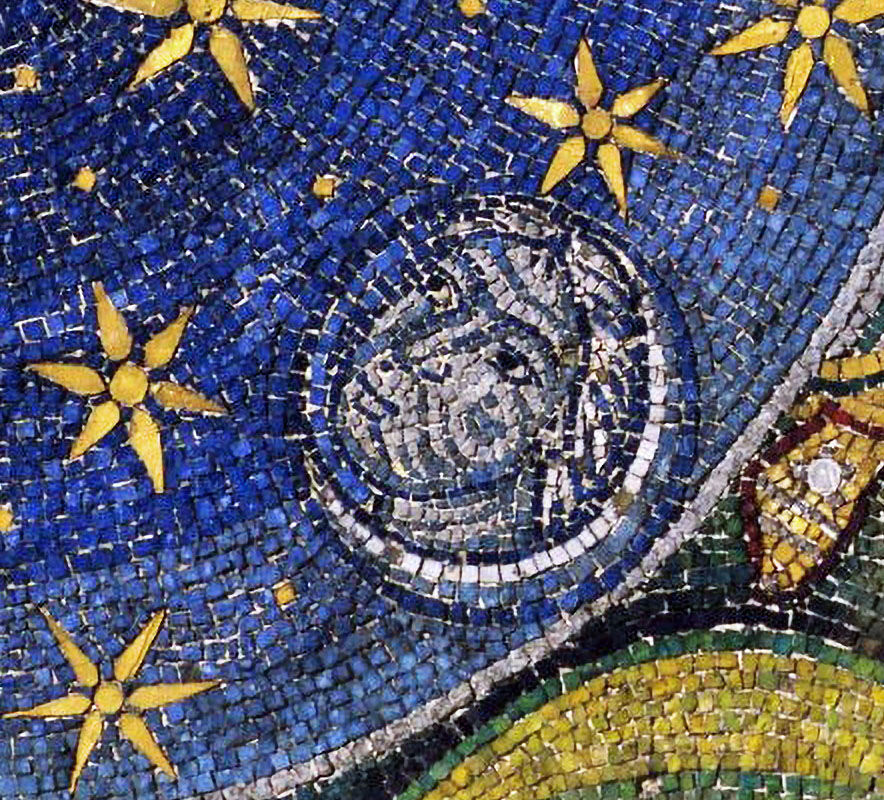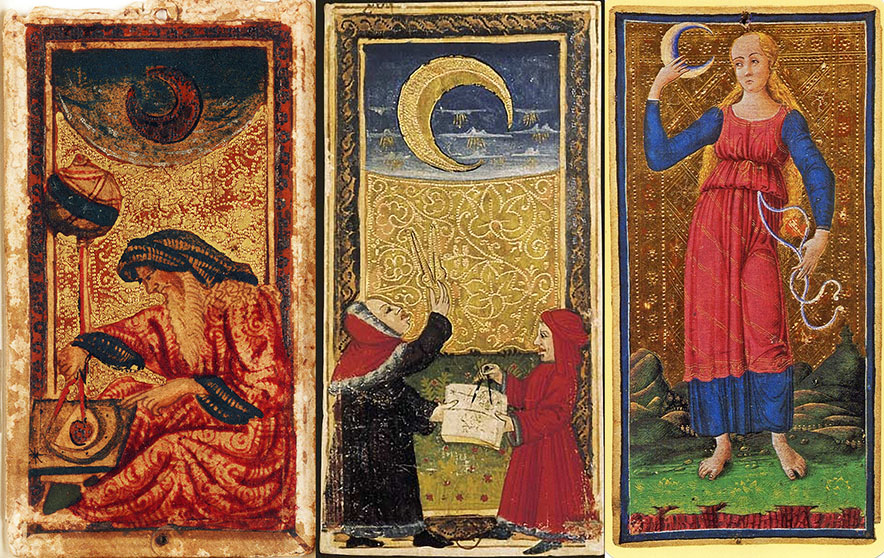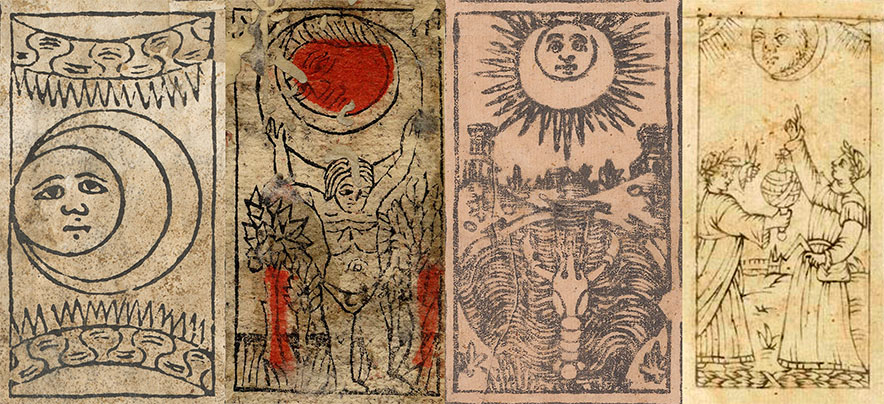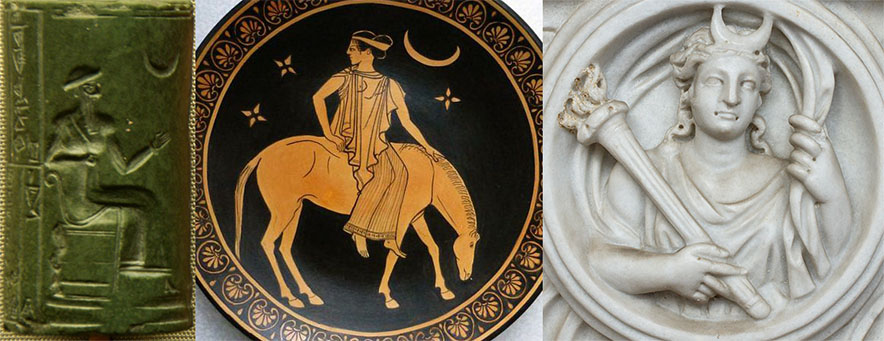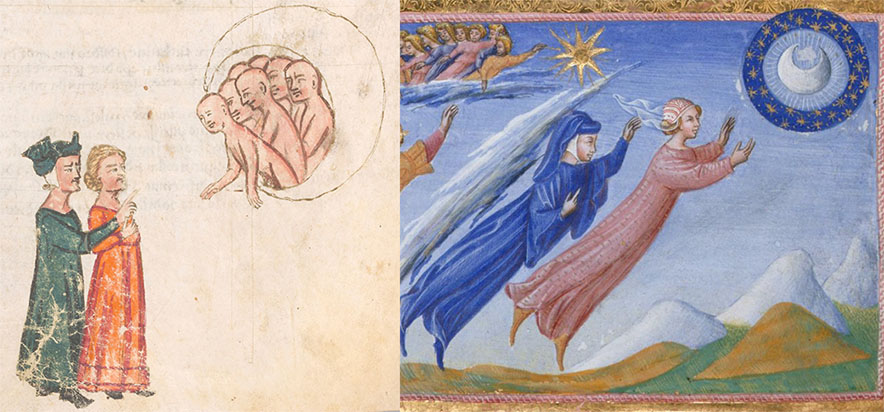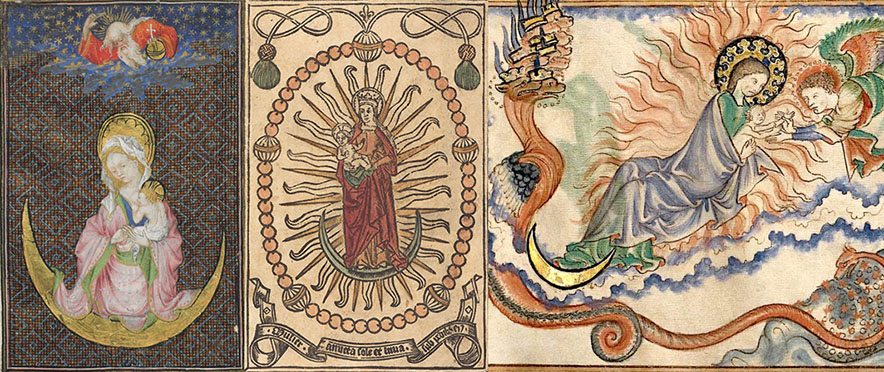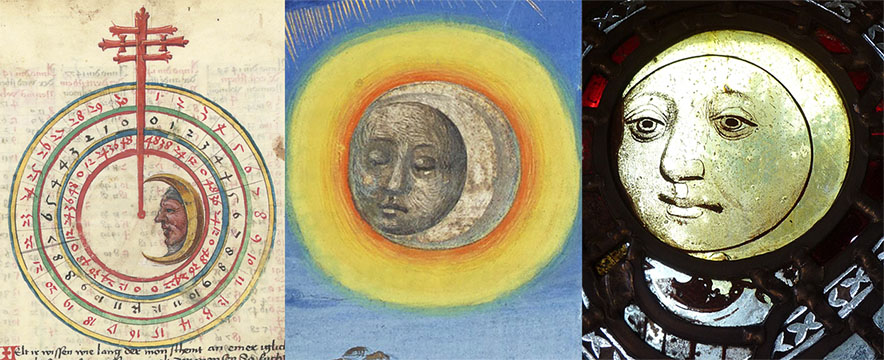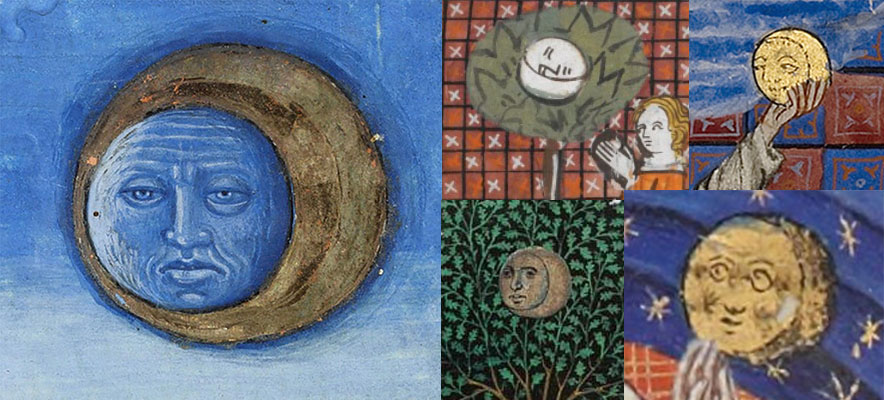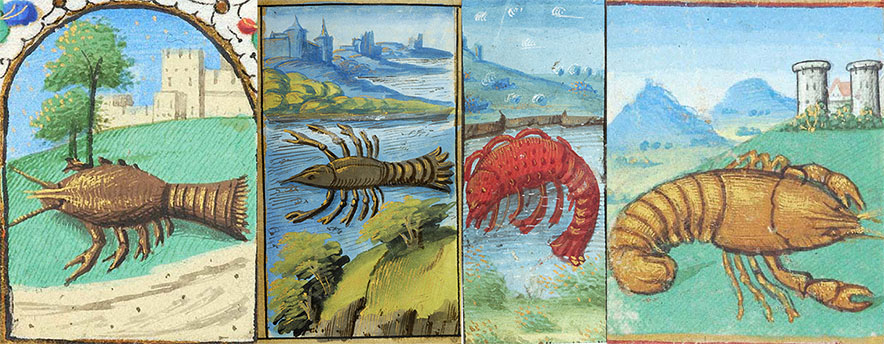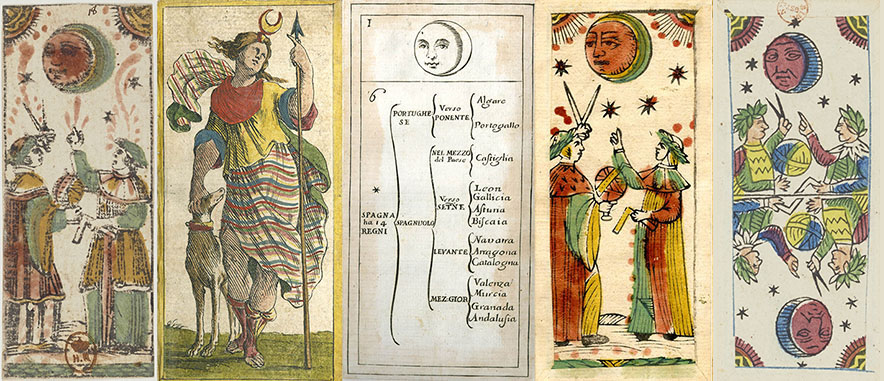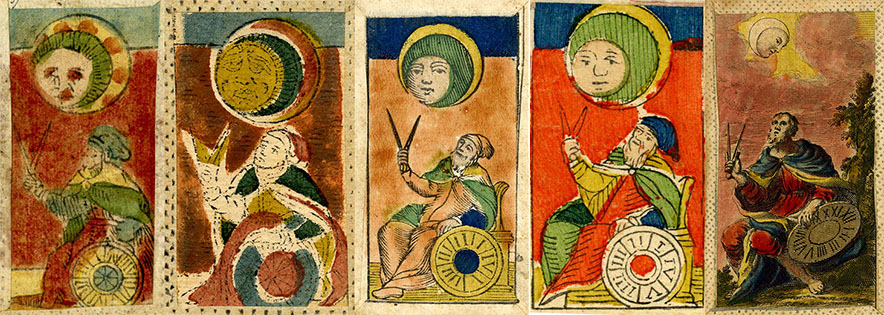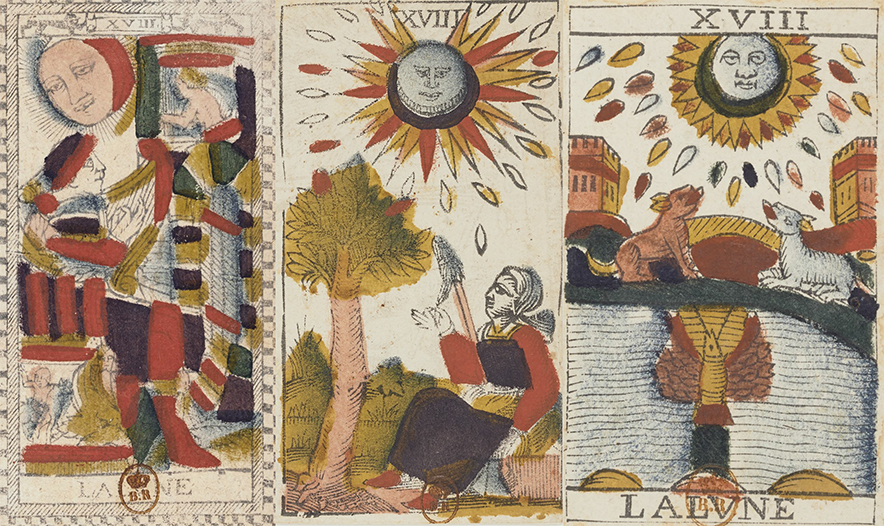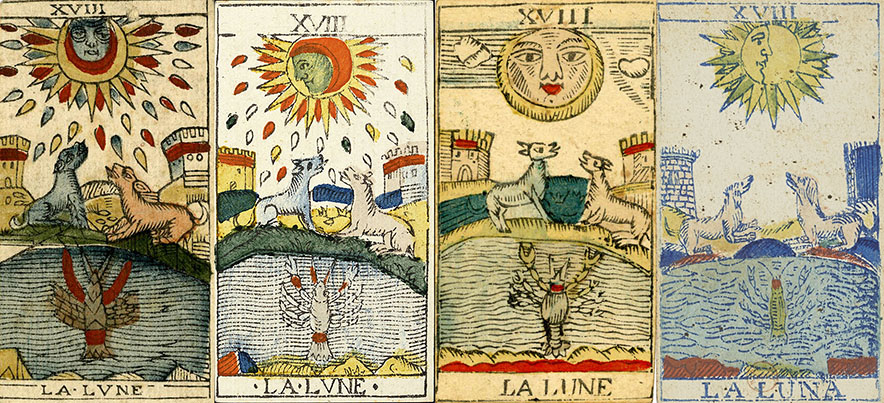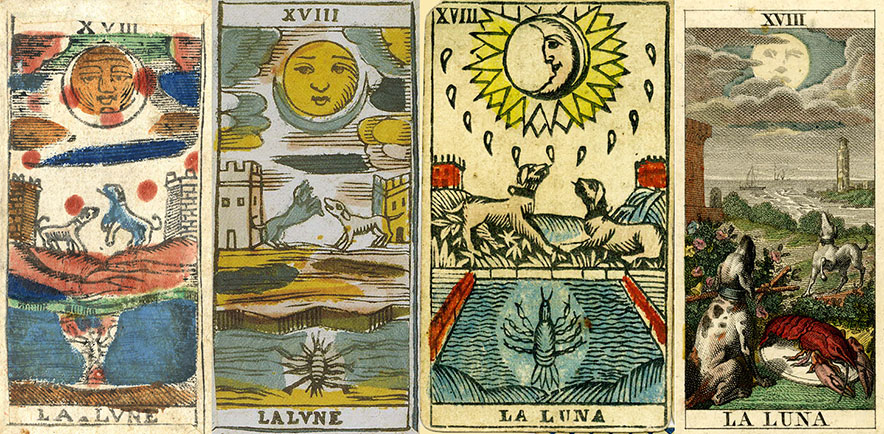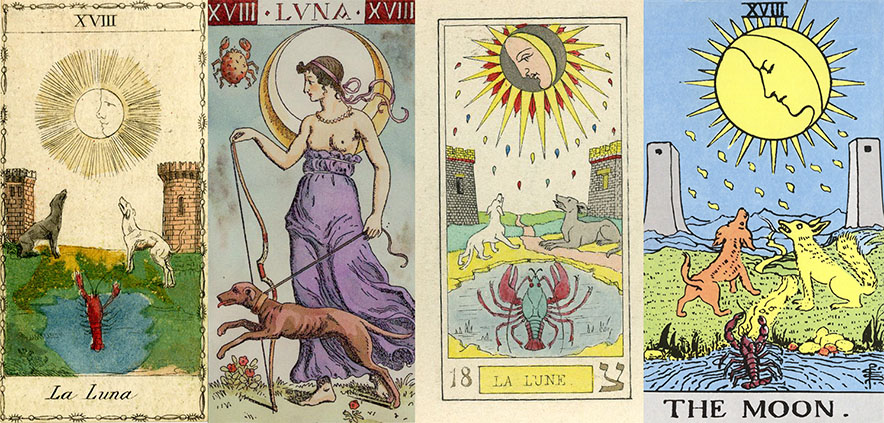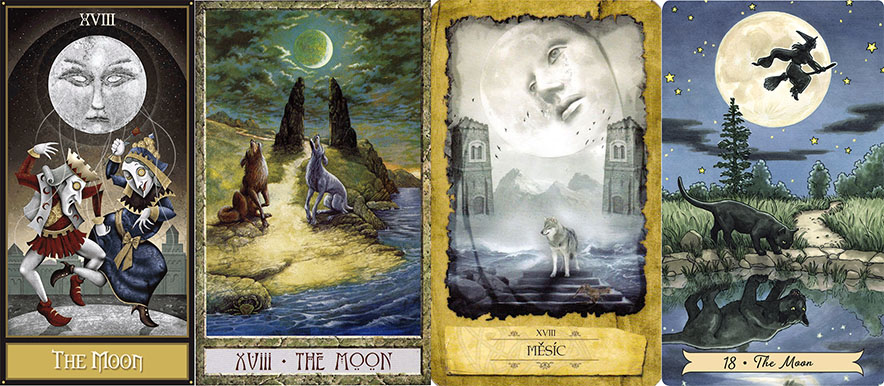THE TAROT WHEEL
LA LUNA - THE MOON
In the Middle ages, the Sun and the Moon are very often pictured together. The golden sun, male symbol by excellence, dominating the day and the silver moon, female symbol, second brightest object in the heavens, dominating the night sky. On the present page however, we describe only the development of the Moon as illustrated on the Tarot cards, so we limit ourselves wherever possible to the representation of the Moon image. Here above a typical medieval representation of the Moon, a detail from a mosaic in the Basilica di San Marco in Venice, dating back to the early 13th Century. The moon is represented as a thin crescent, with a face occupying the major part of the moon circle. The face in the moon is looking upwards to the Sun, that will be represented on the next page
Just like the Star and the Sun, the Moon did not exist on the oldest Tarot (Trionfi) decks. The image was added after 1460, possibly in the Ferrarese court of Este. Let us see how the oldest handpainted cards represented the Moon.
From left to right we have the Moon card from the Este Trionfi deck, the Moon from the Charles VI deck, also made by order of the Ferrarese Este court and the Moon of the Visconti Sforza deck, probably ordered by Ludovico Sforza, future Duke and at that time regent of the Milanese dutchy, attributed to Ferrarese artist Antonio Cicognara. The three images have in common that the Moon is represented as a crescent, covering almost the whole moon circle. On the Este card, the moon is red, so it could be the representation of a Blood moon, an eclipse of the moon. An astrologer is making his calculations, similar as on the Star card of the same deck. Also on the Charles VI deck we see astrologers making calculations, two on this card. On both cards the astrologers have a compass to help making the calculations. In the Middle Ages, this compass was often used as a symbol of God's creation of the world. On the Moon card of the Visconti Sforza deck, we also see an image very similar to the Star image of the same deck, a giant lady placing a crescent moon in the sky. We have to remember that this card postdates the first 70 cards of this deck and that it postdates even the two Ferrarese decks. According most experts this card has been realized in the last quarter of the 15th century, maybe around 1490. Let us now have a look at the block printed cards from the same period.
All four cards were part of uncut sheets found in the bindings of books dated to around 1500. However, an exact dating is impossible. From left to right we have representations of the Moon from the Rosenwald sheet, the Budapest sheet, the Cary sheet and the Rothschild sheets. Just like the hand painted cards, the Moon is represented as a crescent covering the biggest part of the moon circle, but unlike the handpainted cards, all moon images are represented with a face whithin the moon crescent, just as in the image on the top of the page.
On the Rosenwald sheet, probably realized in Bologne or Florence, the Moon is represented in its simplest form, with the crescent moon covering the middle part of the card. The Budapest sheet is probably from Ferrara. Here we see a figure posing like Atlas, carrying the crescent moon high above himselves. The Cary sheet might originate from Milan. Here we see a crawfish in a pond. The moon is high in the sky, between two towers situated on hill tops. The subject of this image is, like on the Star card from this sheet, very similar to the later Tarot de Marseille Moon. On the Rothschild sheet moon we see an image very similar to the Charles VI Moon, with two astrologers making their calculations regarding the Moon. As we shall see further on this page, the image is identical to the standard Tarocchino Moon. We consider the Rothschild sheets as an example of the oldest Tarocchini decks and attribute it for this reason to Bologne.
Before further looking at the development of the Moon card, let us have a look at how the moon was represented in Classic and Medieval Art.
It is obvious that the Moon has been an important symbol for humanity as long as humans have been self-aware. The moon was seen as a Goddess, the ruler of the night. The monthly process of the moon from New Moon, via Full Moon to New Moon again was compared with the human life cyclus, from birth to death. Since the earliest times the moon had an important place in Art. Here above, from left to right, we see a Sumerian cylinder seal dated to 2400 BC with a representation of Nanna, god of the moon, a Greek plate dated to 4 BC depicting the Moon goddess Selene riding a horse during night time and a Roman sarcophage with the goddess Diane, the Roman equivalent of Selene. On all images, the moon is represented as a thin crescent.
In the Middle Ages we also see a lot of representations of the Moon, both in religeous and in nonreligeous art, in this last category as illustrations for poems that had the Moon as a subject. The best known example is Dante's Divine comedy.
The Divine Comedy is a poem by Dante Alighieri written between 1308 and 1320. It describes Dante's vision of afterlife with his travels through Hell, Purgatory and Heaven. In Medieval worldview Heaven consisted of 9 concentric spheres, the first was occupied by the moon. Here above we see two illustrations of this passage of Dante and Beatrice, his unattainable love, through the moon sphere. The first image is an illustration from a mid-14th Centura Fiorentine manuscript, where we see Dante and Beatrice, one of his companions on this journey, talking with people in the moon sphere. The second image is a detail of an illustration made in 1450 by Sienese painter Giovanni di ¨Paolo where we see Dante and Beatrice flying to the moon. On both illustrations the moon is depicted as a thick crescent, filling the major part of a circle.
The best-known image of the moon in religious art is a woman holding a child and standing on a crescent moon.
The first image is from a 15th Century book of hours made in Paris for René d'Anjou and conserved in the French National Library, representing the Madonna and child on a crescent. The second image representing the Madonna and child in a rosary comes from the Rosenwald collection in the National Galley of Art. It has been realized around 1490 by an unknown French artist. Some people state that, while the crescent is an Islamic symbol, these pictures represent the superiority of Christianity over Islam. In fact, both images have probably been inspired by the Bible text Revelation 12:1-2
1 And there appeared a great wonder in heaven; a woman clothed with the sun, and the moon under her feet, and upon her head a crown of twelve stars:
2 And she being with child cried, travailing in birth, and pained to be delivered
The third image clearly represents this Bible text. It comes from an English manuscript dating back to the middle of the 13th Century and conserved in the Paul Getty Museum.
Except for these images, where the moon is clearly linked to a text (religious or not), we also see illustrations of the moon, often associated with the Sun, aa independent symbols in calendars, works about astrology and on some other places. Here below some examples.
On the first row; the leftmost image is part of a calendar created in 1496 in Nuremberg by Johannes von Gmunden. The second picture is from a 1463 translation of a 13th Century encyclopedic manuscript entitled Speculum Historiale realized by Vincent de Beauvois, a Dominican monk. The third image is a medieval stained glass image from the St Mary church in Burnham Deepdale, Norfolk, England. The actual stained glass window is made up of fragments of 14th and 15th Century stained glass images.
On the second line, the first image is from a French manuscript titled Livre de la Vigne nostre Seigneur, dated to around 1460 and conserved in the over four centuries old prestigeous Bodleian Library of the English Oxford University. In the middle two images with as theme the moon in a tree. The upper one is from an English manuscript dated to 1333-1348 and the second one is from a Belgian Manuscript dated to 1448-1449. On the right side two images from French manuscripts, the first one from a book of hours conserved in the Paul Getty museum and dated toapproximately 1360, and the lower one from the Grande Bible Historial of Jean duc de Berry, a 15th Century copy of a late 13th Century manuscript made by Guyart des Moulins. What is common to these images (and to the image at the top of this page) is that the moon is represented as having a face, almost allways looking to the left as the crescent moon when it appears in the European evening sky (most people rarely see the Moon in the morning sky). This moon with a face illustration was in the late Middle Ages a very common representation of the moon when it appeared as a main subject in a drawing, exactly as we have seen on the Tarot sheet images presented earlier on this page. With or without a face, the moon is allways represented as a crescent. But undeniable, the face adds some personality.
The question remains where is the Cary Sheet Moon image based on? The answer seems rather simple, just as on the Cary Sheet the Star was probably inspired by Book of Hours illustrations of the zodiac sign Aquarius, the Cary Sheet Moon is probably also inspired by some Book of Hours illustrations of the zodiac sign Cancer. We will come back to this connection of the three heavenly bodies Star, Moon and Sun with the zodiac, when dealing with the Sun card. Let us see first some examples of the zodiac sign Cancer dating from late 15th Century.
All images are from French books of hours, and all are from the last quarter of the 15th Century. The manuscripts have been made from left to right in the Loire region, Paris, Rouen and Orleans. On all illustrations we see a crawfish, sometimes in water, sometimes on land, with in the distance hills and/or towers. Like on the Aquarius illustrations, where we rarely see stars, no images of the moon are depicted. However, in astrology the house of Cancer is ruled by the moon, so the connexion is easily made.
Now we have some insight about what the pictures of the Moon on the Trionfi and Tarot cards are based on, we can continue to have a look at the Tarot cards. Let us continue with some Italian cards from the Tarot family.
The game of Tarocchino is an amazing game. It existed well before the Tarot de Marseille and people in Bologna and on other palces in Italy are still playing the game. You can find more information about this game here. Here above five cards of the Tarocchino game representing the Moon in different parts of history. The first image is from the very early 17th Century. It is identical to the image of the Rothschild sheet dating from around 1500 and testifying as such that the game of Tarocchino existed at least since the end of the 15th Century. It represents two astronomers making their calculations of the appearance of a red moon, a blood moon, a moon eclipsed by the shadow of the earth. The second image is from a custom made Tarocchino deck; realized around 1668 by Giuseppe Mitelli in order of Filippo Bentivoglio. Here we see a very classical representation of the moon goddess Diane (Selene) with a crescent of the moon on her head, exactly as on the Roman sarcophage presented earlier on this page. The third image is from a game designed by Luigi Montierri in 1721. The image above is from a second version of the game printed in 1725. It is from a geograpgical card Tarocchino game, a style of game very popular in the early 17th Century. The moon is here reduced to a simple crescent with a face within the moon circle. The fourth image is from a Tarocchino game dating to the middle of the 18th Century. We remark that the image did not change in the slightest details since the two and a half Century older Rothschild sheet that was very similar to the Charles VI deck. Around 1760 two headed Tarocchino deck started to appear in Bologne. The fifth image is an example of a two headed Tarocchino moon card dating to the early 19th Century. Essential, the image is identical to the upper half of the Rothschild sheet and up unitil today the game of Tarocchino is played with exactly identical illustrations.
The next moon cards presented here are from a Minchiate game, another game from the Tarot family, born in Florence.
The Minchita game is a game that has been played from the 17th Century up unto the beginning of the 20th Century. It appeared for the first time in Florence, but it spread over a larger geographical area than the Tarocchino game. The Minchiate game is characterized by an extended set of 41 trump cards, The five highest trump cards all have a red beckground and are called the "rossi". The leftmost card above is from one of the oldest Minchite games conserved, dated to around 1675 and made in Florence. The next three moon cards are all from the 18th Century and they are printed in respectively Lucca, Bologna and Rome. Technically speaking, the card from Lucca is not from a Minchiate game. In Lucca there existed a local variant of the Tarot game with a reduced trump set and a moon card identical to the Minchiate moon. The single astrologer is much like the d’Este card shown at the top of the page.
The last cards is a 19th Century Minchiate card printed in Florence. Better printing techniques permitted to refine and redesigne the moon card.
Before presenting the 78 card Tarocchi decks made in Italy, let us first show you how Tarot developped in France and its neighbouring countries.
Three cards in harmonious colors but with different images. The cards have been resized to the same height. We have here the three oldest complete or almost complete known Tarot decks from France, all three printed in Paris in the 17th Century. The first one is the anonymous Tarot of Paris, probably made in the beginning of the 17th Century. On the moon card of this deck we see the balcony scene of Romeo and Juliette, the famous play of William Shakespearr created some years before at the very end of the 16th Century. The second image, from the Tarot deck of Jaques Vievil, realized just before the middle of the 17th Century, seems a little bit displaced, because the card has the same subject as the Sun card of the Charles VI deck, where we see Clotho, the spinster of the thread of life, one of the three Greek Moirai, the Fates of destiny. Is this an error of Vievil or did he this on purpose? On the third card, from the tarot of Jean Noblet, oldest known Tarot de Marseille deck, made around 1659, we see the same scene as on the Cary sheet presented above, a crawfish in a pool with on the background the full moon shining between two towers and in the middle two dogs howling to the moon. This card has probably been inspired by the illustrations of the zodiac sign Cancer in the multiple French books of hours (prayer books), more later on the page dealing with the Sun. The Moon rules the night and as such our fears and our subconsciousness. In the TdM tradition, the trump cards are printed in mirror and as such the Moon reflects our subconsciousness. This Noblet Moon card was the first of a long series of cards in the Tarot de Marseille tradition or inspired by this card as we will see here below. Let us start with the Tarot de Marseille itself.
The left most card is from the Tarot of Jean Dodal, dated to 1701 and realized in Lyon. Unfortunately invisible on this small copy, at the very right side of the green border of the pond we can distinguish the characters I.P. Some scholars think that I.P. stands for Jean Payen, a Lyonese cardmaker active in the same time as Jean Dodal, who could have used the name Jean Dodal on card decks destined for export, this because of the loaden signification of the wordt "payen" in some germanic languages. The card is exactly the same as the moon card of the Jean Noblet deck. The second card has been made by François Héri in Solothurn in Switzerland. The difference with the previous cards is the moon facing to the left side of the card. The Dodal deck belongs to the group of type I TdM decks and the Héri deck is typical for the type II TdM decks. The difference in the moon facing us or looking to the left is one of the characteristics that distinguish type I and type II TdM decks. The third card was printed by Joseph Krebs in Freibourg am Brischau, Germany. This deck belongs to the Tarot of Besançon, a variation of the TdM deck mainly produced in germanic speaking protestant countries. The moon here has a very female face with red lips. The fourth card was realized by F.F.Solesio in 1865 in Genova, Italy and belongs to the family of the Piedmontese Tarot. In this variant of the TdM, the moon is not looking in a fixed direction and we see it here looking to the right. The TdM tradition conquered Italy, where the Tarot game had disappeared in many regions. There is however a discussion going on if the TdM style was developed in Lombardia in Italy or in the region around Lyon in France. So let us go back to the Italian Tarocchi cards (Tarocco is the Italian word for Tarot, Tarocchi is its pluriel form).
Originaly developed in Milan or developed in Lyon, we have to admit that most 17th and 18th Century Tarot decks had French sub-titles. And we also have to admit that all Tarocchi cards presented here above are clearly derived from the TdM model. The first card on the left is from the Bolognese cardmaker Francesco Berti and dates to the second half of the 17th Century. The red dots on the card are typical for 17th Century Italian decks where cardsmakers used this kind of decorations to limit the whitespace. The second very stylish card has been produced in 1799 by Angelo Valla in trieste. Here the moon crescent and the moon face are separate objects. The third card is from a Tarocco deck produced in the second half of the 18th Century by Rossi in Torino. The pond containing the crawfish became here a human made basin. We remark the Italian subtitle. The last card has been designed by the Milanese cardmaker Carlo Dellarocco and has been printed by the German printer Gumppenberg in 1835 in Milano. Due to new printing techniques the cards were redesigned and became very elaborate. But its TdM origins are unmistakeable. Just as Dellarocca, other cardmakers began also to stray a little bit from the very strict TdM pattern
The first card is from the so called Tarot of Lombardia, printed in the early 19th Century, also by Gumppenberg in Milan. Under Napoleontic influences, the style of the card became much more rigid. The next card has been designed in 1893 by Vachetta in a small town close to Torino. Here we return back to the Moon goddess Diane. The faceless moon crescent is illustrated behind Diane's upper body. The Zodiac sign Cancer, which is ruled by the moon, appears in the upper left corner of the card. The next card is from the Swiss occultist Oswald Wirth and designed in 1889. Here we see two new elements appear, a Hebrew character, that is according these occultists corresponding to the card and a small path leaving the pond and going between the two towers until the horizon. The moon is looking very strict and down to the left. These two elements, the strict looking moon face and the path from the pond to the horizon are also visible in the next card, the first card with English subtitles, the Rider-Waite-Smith (RWS) card from 1909. Arthur Edward Waite was an occultist from the Golden Dawn order and his cards opened a whole new usage and public to the Tarot. Thanks in a big part to the RWS deck that popularized the game, today Tarot belongs to everyone and the images fade more and more away from the TdM tradition. Here below some examples.
The Moon is dealing with the subconciousness, clearly visible in the hereabove presented cards. From left to right we have the Deviant Moon Tarot, published by Patrick Valenza in 2016, the Druidcraft Tarot, published in 2009, imagined by Philip and Stephanie Carr-Gomm and illustrated by Will Worthignton, the Moon from the Mystic Dreamer Tarot, published in 2011 and created by Heidi Darra and Barbara Moore and at last the moon card of the Everyday Witch Tarot, created by Elisabeth Alba and Deborak Blake in 2017. Like most modern tarot decks, these are all very personal interpretations of the different tarot cards, that are leaving tradition more and more behind, be it the TdM tradition or the RWS tradition.
With this presentation of the modern moon cards, we are at the end of our journey through the history of the development of the Moon card, on the oldest cards focussing on astrology, religion and mythology, to become a mirror of our subconsciousness in the TdM decks, a value that it kept until today.
